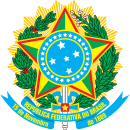
Back Llingües de Brasil AST ব্রাজিলের ভাষা Bengali/Bangla Llengües del Brasil Catalan Jazyky Brazílie Czech Sprachen in Brasilien German Lenguas de Brasil Spanish Langues au Brésil French Linguas do Brasil Galician Jezici Brazila Croatian Bahasa di Brasil ID
| Languages of Brazil | |
|---|---|
 English, Portuguese and Spanish welcome signs in Acaiaca | |
| Official | Portuguese - 99.5% |
| Main | Portuguese[1][2][3] |
| Indigenous | Apalaí, Arára, Bororo, Canela, Carajá, Carib, Guarani, Kaingang, Nadëb, Nheengatu, Pirahã, Terena, Ticuna, Tucano, Tupiniquim, Wanano, Ye'kuana |
| Regional | German, Italian, Lombard, Venetian, Neapolitan, Japanese, Spanish (border areas), Polish, Ukrainian, English,[4] East Pomeranian, Romani |
| Vernacular | Brazilian Portuguese |
| Immigrant | German, Italian, Lombard, Venetian, Neapolitan, Levantine Arabic, Polish, Ukrainian, Russian, Japanese, Spanish, English, Chinese, Hebrew |
| Foreign | English, Japanese, Swedish, German, Italian |
| Signed | Brazilian Sign Language Ka'apor Sign Language Terena Sign Language |
| Keyboard layout | |
| Part of a series on the |
| Culture of Brazil |
|---|
 |
| Society |
| Topics |
| Symbols |
Portuguese is the official and national language of Brazil,[5] being widely spoken by nearly all of its population. Brazil is the most populous Portuguese-speaking country in the world, with its lands comprising the majority of Portugal's former colonial holdings in the Americas.
Aside from Portuguese, the country also has numerous minority languages, including over 200 different indigenous languages, such as Nheengatu (a descendant of Tupi), and languages of more recent European and Asian immigrants, such as Italian, German and Japanese. In some municipalities, those minor languages have official status: Nheengatu, for example, is an official language in São Gabriel da Cachoeira, while a number of German dialects are official in nine southern municipalities.
Hunsrik (also known as Riograndenser Hunsrückisch) is a Germanic language[6] also spoken in Argentina, Paraguay and Venezuela,[7][8] which derived from the Hunsrückisch dialect. Hunsrik has official status in Antônio Carlos and Santa Maria do Herval, and is recognized by the states of Rio Grande do Sul and Santa Catarina as part of their historical and cultural heritage.[9][10]
As of 2023, the population of Brazil speaks or signs 238 languages, of which approximately 217 are indigenous and others are non-indigenous.[11] In 2005, no indigenous language was spoken by more than 40,000 people.[12]
With the implementation of the Orthographic Agreement of 1990, the orthographic norms of Brazil and Portugal have been largely unified, but still have some minor differences. Brazil enacted these changes in 2009 and Portugal enacted them in 2012.
In 2002, the Brazilian Sign Language (Libras) was made the official language of the Brazilian deaf community..[13]
On December 9, 2010, the National Inventory of Linguistic Diversity was created,[14] which will analyze proposals for revitalizing minority languages in the country.[15] In 2019, the Technical Commission of the National Inventory of Linguistic Diversity was established.[16][17]
- ^ "Hunsrückish". Ethnologue. Retrieved 20 July 2015.
- ^ Vilela, Soraia (20 April 2004). "O alemão lusitano do Sul do Brasil". DW (in Portuguese). Retrieved 16 September 2022.
- ^ "Standard German". Ethnologue. Retrieved 20 July 2015.
- ^ "Geography of Brazil". The World Factbook. Central Intelligence Agency. 2016. Retrieved 31 October 2016.
- ^ According to the Brazil Constitution, article 13: "A língua portuguesa é o idioma oficial da República Federativa do Brasil."[1]
- ^ Altenhofen, Cleo Vilson; Morello, Rosângela (2018). Hunsrückisch: Inventário de uma língua do Brasil. Garapuvu. hdl:10183/194384. ISBN 978-85-907418-7-9.
- ^ "Projeto Hunsrik completa 15 anos no mês de fevereiro". O Diário (in Portuguese). 19 February 2019. Archived from the original on 31 October 2020. Retrieved 16 September 2022.
- ^ "Projeto Hunsrik completa 15 anos no mês de fevereiro". Grupo O Diário (in Brazilian Portuguese). 19 February 2019. Retrieved 27 February 2022.
- ^ "Lei N.º 14.061, de 23 de julho de 2012". 30 March 2019. Archived from the original on 30 March 2019. Retrieved 23 June 2020.
- ^ Documentação, Coordenadoria de. "LEI Nº 16.987, DE 3 DE AGOSTO DE 2016". leis.alesc.sc.gov.br. Retrieved 7 June 2022.
- ^ "Brazil". Ethnologue. Retrieved 27 May 2021.
- ^ Aryon Dall'Igna Rodrigues (April 2005). "Sobre as línguas indígenas e sua pesquisa no Brasil". Ciência e Cultura (in Portuguese). 57 (2). Sociedade Brasileira para o Progresso da Ciência: 35–38. Retrieved 12 August 2012.
- ^ Piconi, Larissa Bassi (2014). "Teaching languages to deaf students in Brazil at the intersection of discourses". Revista Brasileira de Linguística Aplicada. 14 (4): 881–904. doi:10.1590/S1984-63982014005000022. ISSN 1984-6398.
- ^ Presidente institui inventário
- ^ Decreto cria Inventário Nacional da Diversidade Linguística
- ^ Decreto Nº 9.938, de 24 de julho de 2019, Institui a Comissão Técnica do Inventário Nacional da Diversidade Linguística
- ^ Governo cria comissão técnica para avaliar a inclusão de línguas no Inventário Nacional de Diversidade Linguística, G1
